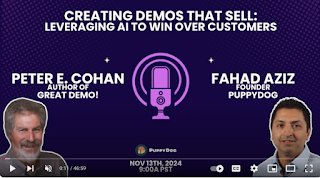Listen to one of your favorite songs… What do you hear?
Loud sections vary with soft passages, swelling and diminishing, cymbal crashes and silence… Scooping vocals and runs that end with subtle vibrato…
It’s amazingly stimulating, and it keeps us engaged, often deeply!
Musicians use methods to engage audiences that we can also apply in our demos to drive similar engagement.
Dynamics, for example, are the louds and softs of music, and you can draw people in by alternating them. Speaking normally followed by a dramatic decrease in volume literally causes an audience to lean forward and listen more closely. This is particularly useful when you want to communicate an important point.
The Power of the Pause: In music, a moment with no sound can be extremely dramatic. When you describe a key screen or idea, pause to give your audience time to absorb the concept, think about it, and provide a comfortable gap for questions or comments. There is no requirement to fill “dead air!”
The use of alliteration and careful word selection impacts your audience’s attention. Hard consonants and sibilants are percussion to the melody of your sentences.
Explore this for yourself! Listen to some of your favorite music and note the dynamics, pauses, crescendos, fermatas, and other hooks designed to engage and stimulate you. (For extra credit, identify the movement of Tchaikovsky’s fifth symphony that has that fabulous ringing pause!)
Musicians listen carefully and respond to one another in nearly all types of music, just as we should do in demos with our prospects. They also engage in musical conversations in many genres, ranging from “call and response” (e.g., Ray Charles’ “What’d I Say”) to the rich dialogs found in jazz, blues, rock, bluegrass, baroque, classical, romantic, modern, and contemporary music.
Take a note from music and apply these ideas in your demos!
For more tips and practical practices, grab a copy of Great Demo! (even better, listen to the Audiobook version!).
















